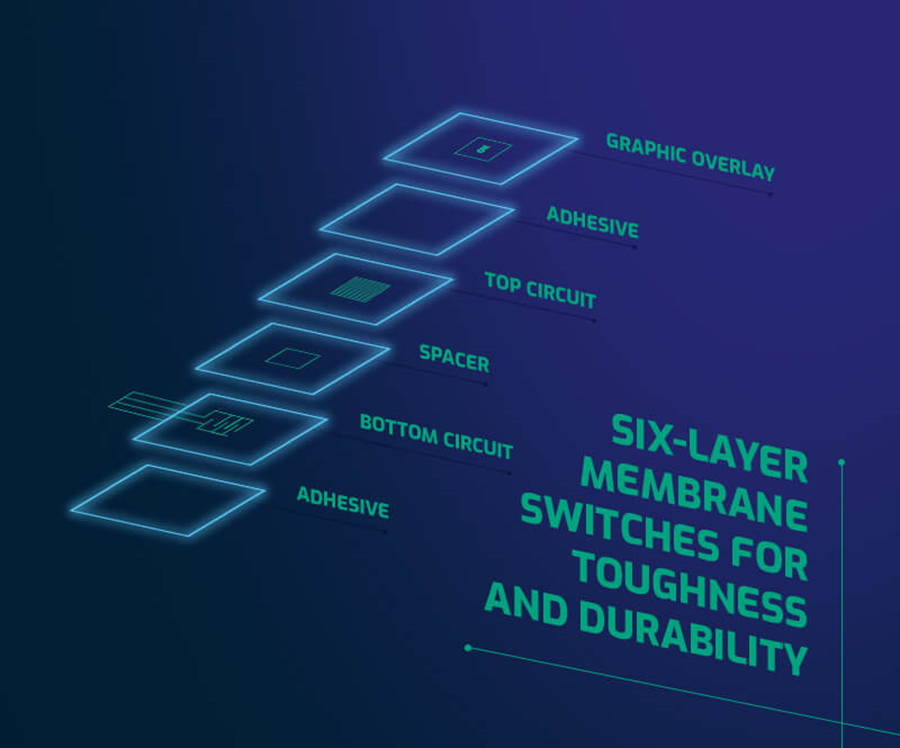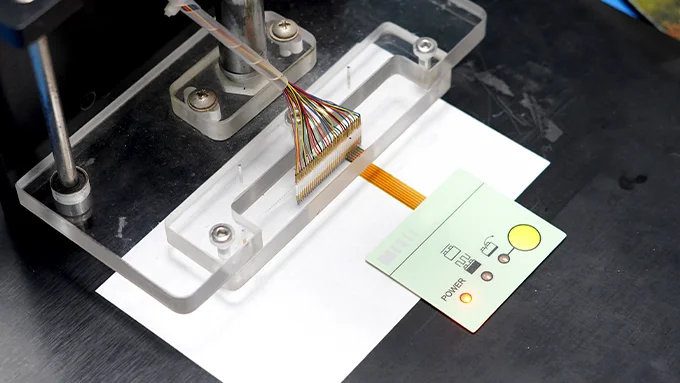Everything About Membrane layer Switch Over: A Comprehensive Overview for Beginners
Membrane switches are vital elements in contemporary electronics, using a special user interface for user communication - membrane switch. Their layered building and construction, consisting of overlays and conductive traces, offers functionality and longevity. Unlike traditional mechanical switches, membrane switches offer a streamlined design and adjustable alternatives. Understanding their key attributes and advantages can transform item layout. The ins and outs of their application and layout factors to consider call for more exploration.
What Is a Membrane layer Switch?
A membrane button is a kind of electrical button that includes a flexible membrane layer layered over a published circuit card. This design allows for a smooth and compact user interface, commonly used in numerous electronic devices. Membrane buttons are commonly discovered in customer home appliances, medical devices, and industrial equipment because of their durability and resistance to environmental factors.The building typically includes multiple layers, such as visuals overlays and adhesive support, which provide tactile comments and shield the wiring underneath. The procedure of a membrane button is launched when stress is related to the surface area, finishing an electrical circuit.These switches are valued for their flexibility, enabling custom designs and published graphics that accommodate details interface. Their low-profile nature lowers area requirements, making them optimal for applications where standard buttons might not fit. Generally, membrane switches offer a useful and aesthetic solution for modern-day electronic tools.
Secret Components of Membrane Changes
Membrane layer switches over comprise numerous essential elements that add to their functionality and efficiency. The top layer, called the overlay, supplies the interface and is typically published with graphics or symbols. Beneath the overlay lies a spacer layer, which separates the conductive elements and protects against inadvertent activation. The following vital element is the visuals layer, which enhances appearances and guarantees the resilience of the design.Conductive traces, commonly made from materials like silver or carbon, are printed on the circuit layer. When pressure is put on the overlay, these traces enter into contact, completing the circuit. In addition, a backing layer offers structural support and can be made from materials such as polyester or polycarbonate. With each other, these elements produce a trusted, user-friendly user interface ideal for numerous applications, from household home appliances to industrial equipment. Comprehending these aspects is important for anybody interested in membrane layer switch modern technology.
How Membrane Changes Job
Recognizing just how membrane switches over function is crucial for valuing their prevalent use in various devices. A membrane switch runs via a series of layers, including a graphic overlay, spacer, and a circuit layer. When pressure is applied to the overlay, it presses the spacer layer, permitting the circuit layer to make contact and complete an electrical circuit. This activity sends out a signal to the device, motivating a response, such as switching on a light or activating a function.Membrane switches can be created with numerous attributes, including responsive comments, backlighting, and custom-made graphics, improving customer communication. Their building permits a closed design, shielding the internal components from dust, dampness, and impurities. This resilience makes them ideal for diverse applications, from consumer electronics to industrial tools. Generally, the simpleness and performance of membrane layer changes add to their appeal in modern technology.
Benefits of Membrane Layer Switches Over Over Mechanical Buttons
While mechanical buttons have actually long been a staple in several tools, membrane layer changes offer distinct advantages that make them significantly appealing. One considerable benefit is their slim account, enabling even more small styles and greater adaptability in product advancement. Additionally, membrane changes attribute a consistent surface, which enhances visual charm and simplifies cleansing, making them appropriate for atmospheres where hygiene is critical.Another benefit is their resistance to dirt and dampness. Unlike mechanical buttons, which can be endangered by environmental elements, membrane buttons provide a closed user interface that protects versus contaminants - membrane switch. Membrane buttons commonly have a longer life-span due to less relocating components, resulting in enhanced resilience and reliability.Cost-effectiveness is additionally a notable advantage, as membrane switches can be produced in bulk with reduced manufacturing prices. These elements combine to position membrane layer switches as a functional choice to conventional mechanical choices in different applications
Common Applications of Membrane Layer Changes
Membrane switches are widely used in different markets, specifically in customer electronic devices and industrial control panels. In consumer tools, they supply a sleek, easy to use interface, while in industrial setups, they enhance longevity and functionality. Recognizing these applications highlights the convenience and practicality of membrane layer buttons in modern innovation.
Customer Electronic Devices Tools
As consumer electronic devices remain to advance, membrane layer switches have actually come to be a prominent option for a selection of tools due to their flexibility and streamlined design. These buttons are commonly located in smartphones, tablets, and push-button controls, where room is limited and aesthetics matter. Their reduced account and customizable layouts enable producers to develop easy to use interfaces that boost the overall individual experience. Additionally, membrane layer switches are commonly made use of in devices such as microwaves and coffee machine, giving user-friendly control options while withstanding moisture and dust. The sturdiness and integrity of membrane switches make them appropriate for everyday customer products, making sure longevity and consistent efficiency. In general, their combination in consumer electronic devices mirrors a mix of performance and modern-day style.
Industrial Control Panels
The applications of membrane switches over prolong beyond consumer electronic devices, discovering significant usage in industrial control panels. These buttons are preferred for their durability and resistance to severe atmospheres, making them suitable for making and process control settings. They give a dependable interface for operators to regulate equipment, screen processes, and change setups. Membrane buttons can be personalized to match specific functional demands, integrating attributes like backlighting and responsive feedback, enhancing customer experience. Their inconspicuous style allows for combination right into numerous devices, while their capacity to hold up against spills, dust, and extreme temperature levels assurances long life. On the whole, membrane layer buttons add to risk-free and effective operation in industrial applications, showing their adaptability and effectiveness sought after atmospheres.
Factors To Consider for Creating Membrane Layer Switches Over
When creating membrane layer buttons, selecting the best materials is vital to ensure durability and performance. Additionally, comprehending layer configuration techniques can greatly impact the button's performance and individual experience. These considerations play an important function in creating dependable and efficient membrane layer switch styles.
Material Choice Relevance
Product selection plays a crucial role in the layout and functionality of membrane layer buttons. The picked products directly influence the switch's longevity, responsive action, and total visual. Key factors to consider include the substrate, which must give architectural stability while permitting adaptability, and the graphic overlay, which needs to be immune to use and ecological aspects. Conductive products should ensure trustworthy electric performance, while adhesives have to provide strong bonding without endangering the switch's procedure. Furthermore, compatibility with producing processes and end-user atmospheres is vital; materials must endure differing temperatures, moisture degrees, and chemical direct exposure. Eventually, proper product selection not just enhances the membrane switch's efficiency but additionally adds to its longevity and user complete satisfaction, making it a vital element of the layout process.

Layer Setup Methods

Regularly Asked Concerns
How Lengthy Do Membrane Layer Changes Commonly Last?
Membrane switches generally have a lifespan of 1 to 5 million cycles, relying on use and ecological problems. Elements such as design top quality and operating frequency substantially influence helpful hints their durability and total efficiency long life.

Can Membrane Layer Switches Be Custom-made for Specific Styles?
Membrane switches can without a doubt be personalized to suit specific styles, permitting for diverse shapes, colors, and capabilities. This versatility enables makers to tailor these switches to meet unique visual and operational demands properly.
What Materials Are Utilized in Membrane Switch Building?
Membrane buttons are normally built using products such as polyester, polycarbonate, and glue layers. These materials provide durability, resistance, and flexibility to environmental variables, ensuring the switches operate successfully in numerous applications and conditions.
Are Membrane Layer Switches Immune or water-proof to Dampness?
Membrane switches can be made to be moisture-resistant, making use of specialized finishings and materials. Their waterproof abilities depend on building top quality and certain applications, making it important to assess requirements for suitable efficiency in different environments.
How Are Membrane Layer Changes Fixed if Damaged?
Fixing broken membrane layer switches over commonly involves changing the influenced layer or circuit. Service technicians might likewise apply conductive sticky or use specialized fixing packages, guaranteeing performance is restored without full substitute of the entire switch setting up. Unlike conventional mechanical switches, membrane buttons offer a streamlined layout and customizable options. A membrane button is a type of electrical button that consists of a flexible membrane layer layered over a printed circuit board. The procedure of a membrane button is started when pressure is applied to the surface area, completing an electrical circuit.These buttons are valued for their versatility, making it possible for personalized layouts and published graphics that provide to particular customer interfaces. While mechanical switches have actually long been a staple in several tools, membrane switches over deal distinct benefits that make them increasingly appealing. Membrane layer buttons usually have great site a longer life-span due to fewer moving parts, resulting in improved sturdiness and reliability.Cost-effectiveness is additionally a notable benefit, as membrane buttons can be produced in bulk with lower manufacturing expenses.